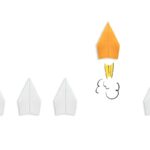
One big question heading into 2022 is whether business creation will remain at elevated levels, as … [+]
New business creation in the United States unexpectedly—yet happily—increased in 2020 and 2021. Reasons for the increase can be discerned: layoffs, shifts in how people want to work, industry changes including the move to more online commerce, greater shipping needs, etc. But we can’t necessarily discern the future course of entrepreneurship in the existing data. We can try to project and predict; there are good reasons to be both optimistic and pessimistic.
To arrive at some semblance of a forecast, let’s review what we know.
The Pandemic Surge
From July 2004 through February 2020, according to the Business Formation Statistics from the Census Bureau, monthly business applications in the United States averaged roughly 231,000. (A business application is an application filed for an employer identification number, EIN.)
That’s just an average, of course. As can be seen in the chart below, business applications fell slightly during the Great Recession in 2008-09 and recovered very slowly. Around 2015, the number started ticking upward. The monthly average from 2015 through February 2020 was 24% higher than the 2009-2015 period.
Not surprisingly, business applications contracted sharply in March and April 2020. The number in April was 22% lower than in February. Nobody quite expected what happened next.
In May 2020, business applications rebounded—and then took off. Since June 2020, the average number of monthly business applications has been 92% higher than between July 2004 and February 2020.
MORE FOR YOU
Business Applications—total and High Propensity—have surged to record levels since mid-2020.
Something similar has occurred with “high propensity” business applications, those the Census Bureau deems to have a strong likelihood of becoming employer firms. High-propensity business applications never actually recovered from 2008-09. From July 2009 through February 2020, the monthly average was 18% lower than from 2004 through 2007.
These types of applications also declined sharply in the first two months of the pandemic, falling 31% from February to April 2020. As can be seen in the FRED chart, the monthly average of high-propensity business applications rocketed upward in mid-2020 and has remained at record levels. Since June 2020, the average has been 39% higher than between July 2004 and February 2020.
Optimism And Pessimism
Business applications, according to the BFS data, have plateaued for the last four or five months. The question is whether this represents a permanently higher level of business creation, or the beginning of a slowdown and regression to pre-pandemic levels.
QuickBooks weighed in recently, saying “there’s no sign of the trend slowing down.” Extrapolating recent business application totals forward, QuickBooks projects there will be 5.6 million business applications in 2022. That would represent a 28% increase over the record-setting year of 2020.
This could be the low end of QuickBooks’ estimate because, according to a recent survey they conducted, 17 million people will “make the leap” to start a new business in 2022. (Not all of them will file for an EIN, hence the difference from the 5.6 million projection.)
In its last analysis of BFS data, released in October, the Economic Innovation Group (EIG) pointed to “reasons to be cautious in interpreting the apparent surge in business formation.” Among those reasons are uncertainty about what, exactly, is driving the surge. Is it the Great Resignation? A near-term reaction to the pandemic? Something else? Additionally, EIG points out that firms started during recessions tend to “remain smaller” than those created during expansions. Others are even more pessimistic: “one should not be overly optimistic about jobs created in this wave of startups.”
The pandemic recession, however, was incredibly short and quite unlike a “typical” downturn. We may not be able to directly apply lessons from past recessions to this one. At the same time, it seems likely that there are many “missing entrepreneurs” in the pandemic surge. We know that certain types of business owners—women, Blacks, immigrants—felt a greater negative impact early in 2020 than white men.
What we don’t know is the demographic breakdown of the increase in business applications. If it mirrors pre-pandemic patterns, then disparities in entrepreneurship and business ownership will not only persist but also widen. Continued disparities would weigh down overall business creation.
Business Creation In 2022 Will …
There is at least one observation we can make with fair certainty. The volume of business failure is likely to be historically high in 2022 (and beyond). An overall increase in new businesses naturally creates an overall increase in businesses closing. What about further business creation?
We need to remember that, prior to the pandemic, business creation in the United States had basically been flat for many years. EIG called it a “lost decade” for American entrepreneurship. Some of the deep-seated and long-term factors contributing to stagnant business creation are unlikely to have shifted in the last year. For example, slow growth in the labor force has been cited as one cause of the long-term decline in business creation. That has definitely not reversed during Covid.
It appears true that the spike in business applications was driven by layoffs early in the pandemic. The PIIE analysis cited above claims that the pandemic surge is “attributed largely to entrepreneurship by necessity.” Setting aside the need to discard this outdated mischaracterization of entrepreneurship, there is validity to the observation. Yet as the labor market has tightened in 2021, we haven’t seen a corresponding decrease in business applications. As noted, the monthly numbers (total and high-propensity) have remained steady for several months.
A reasonable forecast is that total business applications, and those from likely employers), will be lower in 2022 than in 2020 or 2021, but higher than the pre-pandemic average. Many of those who started businesses in 2020 and 2021 and fail will try again, whether in 2022 or future years. That will help keep business formation at an elevated level. Something difficult to measure, what my friend and former colleague Paul Kedrosky calls “fractional entrepreneurship,” will increase as many first-time entrepreneurs re-enter the labor force but retain their side hustle.
The wild card is demographic composition. If we can close disparities in business ownership and entrepreneurship, we can help make the pandemic surge a permanent trend. If not, we’ll see both a lower level of business formation for many years and a loss of entrepreneurial dynamism overall.
What’s your prognosis?







